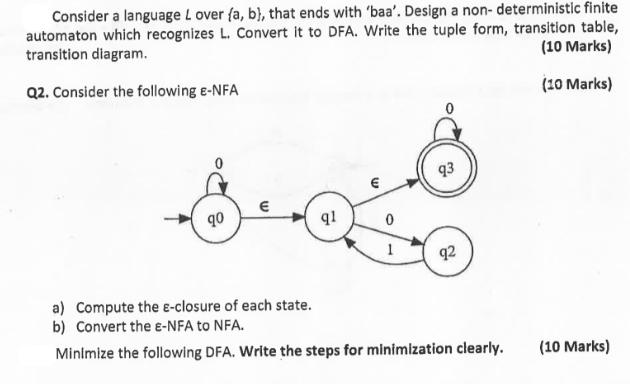Answered step by step
Verified Expert Solution
Question
1 Approved Answer
Consider a language L over (a, b), that ends with 'baa'. Design a non- deterministic finite automaton which recognizes L. Convert it to DFA.

![92 0 0,1 0,1 b 95 Q4. Design a Finite Automata from the given Regular Expression [ab+ (b + aa) b* a]. Write](https://dsd5zvtm8ll6.cloudfront.net/si.experts.images/questions/2023/09/6513fde6d0fc0_1695808991841.jpg)
Consider a language L over (a, b), that ends with 'baa'. Design a non- deterministic finite automaton which recognizes L. Convert it to DFA. Write the tuple form, transition table, transition diagram. (10 Marks) Q2. Consider the following e-NFA (10 Marks) 90 q1 93 92 a) Compute the e-closure of each state. b) Convert the e-NFA to NFA. Minimize the following DFA. Write the steps for minimization clearly. (10 Marks) 92 0 0,1 0,1 b 95 Q4. Design a Finite Automata from the given Regular Expression [ab+ (b + aa) b* a]. Write the step by step construction. (10 Marks) Q5. Convert the following DFA to a Regular expression using Arden's Theorem. (10 Marks)
Step by Step Solution
★★★★★
3.49 Rating (146 Votes )
There are 3 Steps involved in it
Step: 1
Q4 To design a Finite Automata FA from the given regular expression ab b aa b a we can follow these stepbystep constructions Step 1 Start by creating ...
Get Instant Access to Expert-Tailored Solutions
See step-by-step solutions with expert insights and AI powered tools for academic success
Step: 2

Step: 3

Ace Your Homework with AI
Get the answers you need in no time with our AI-driven, step-by-step assistance
Get Started


